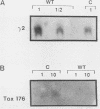Abstract
We have previously generated microphthalmic mice lacking lens fiber cells by targeting the expression of the diphtheria toxin A (DT-A) gene in transgenic mice with regulatory sequences associated with the mouse gamma 2-crystallin gene. Because of the extreme toxicity of DT to animal cells and the potential leakiness of many tissue-specific regulatory regions, we investigated whether there might be an experimental advantage in using a mutant, attenuated form of the DT-A gene (tox-176) fused to gamma 2-crystallin regulatory sequences to ablate fiber cells in the ocular lens. In contrast to the microphthalmia observed in transgenic animals carrying the native DT-A gene, independent lines of mice transgenic for the gamma 2tox176 construct displayed predominantly cataracts or clinical anophthalmia. These contrasting phenotypes were transmitted within each pedigree, although for some lines some phenotypic heterogeneity among offspring was noted. The difference in phenotype between cataractous and clinically anophthalmic transgenic lines could not be ascribed to differences in the transgene copy number. Instead, the results suggest that transgene expression and hence the extent of genetic ablation are modulated by the site of chromosomal integration and, to a lesser extent, by epigenetic events. They also suggest that the attenuated gamma 2tox176 construct can integrate into chromosomal regions that are particularly favorable for expression without compromising embryological development and therefore that the tox-176 gene may be more versatile and effective than the wild-type DT-A gene for achieving genetic ablation with a broad range of cell- or tissue-specific regulatory sequences.
Full text
PDF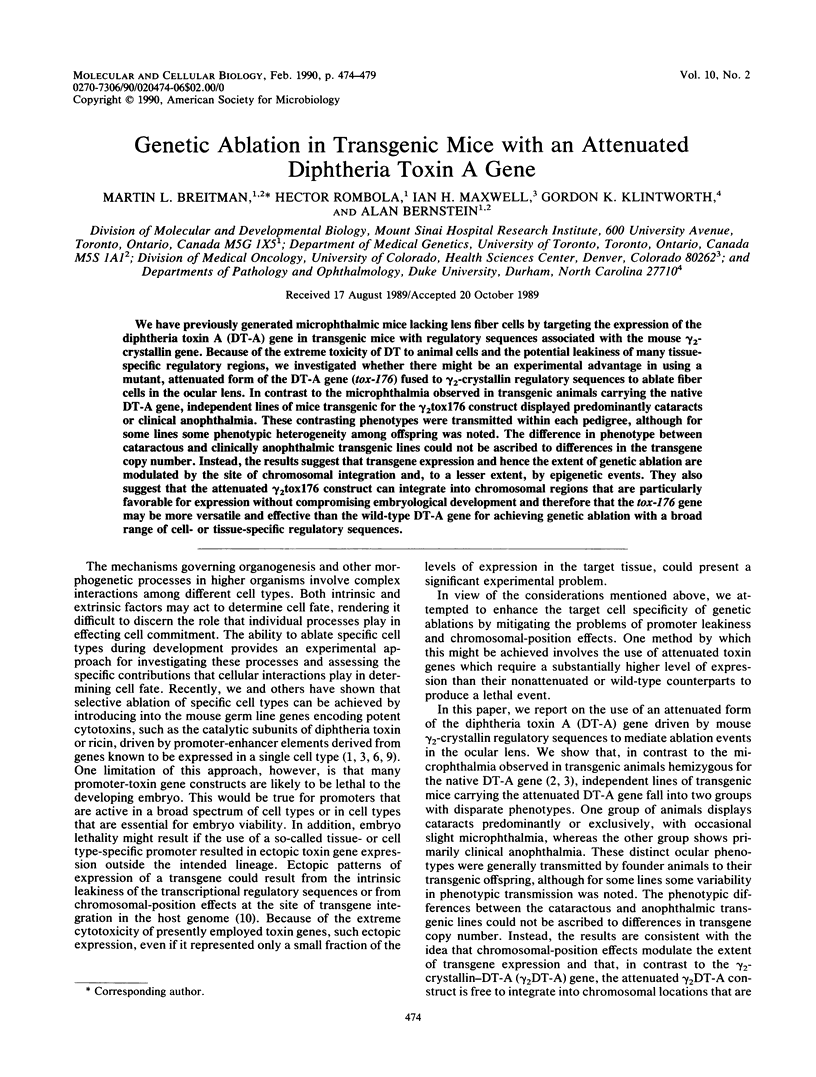
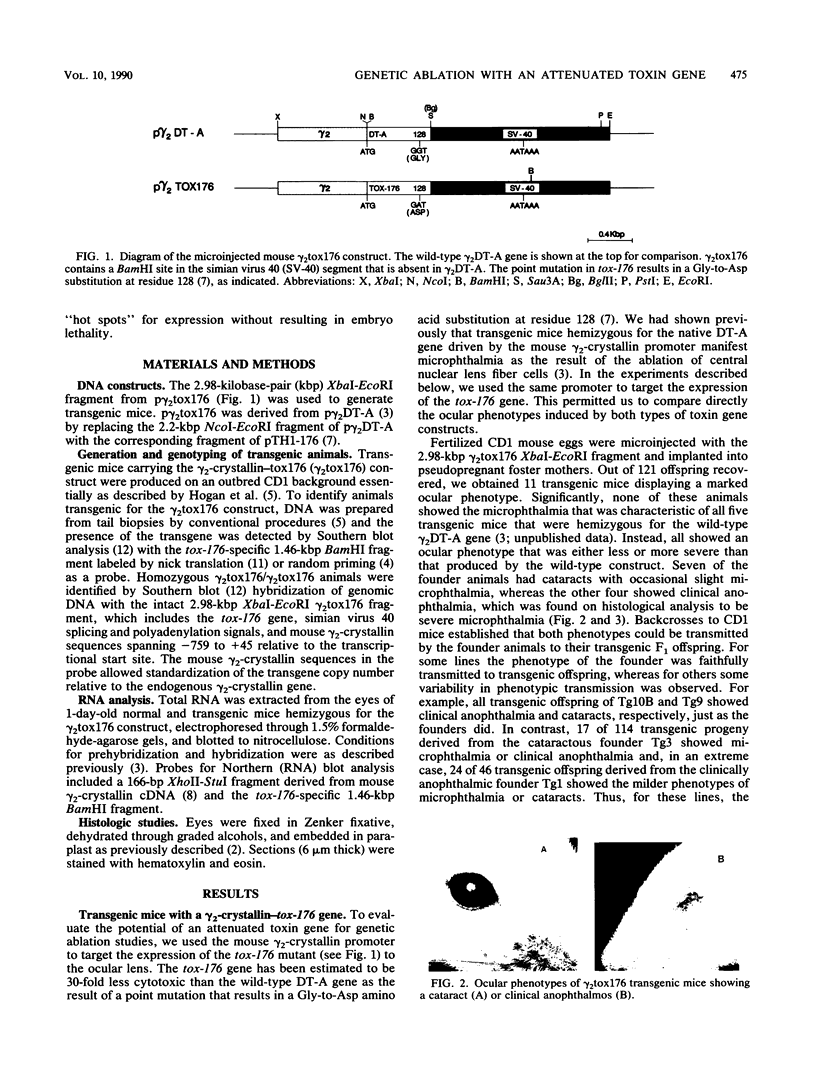
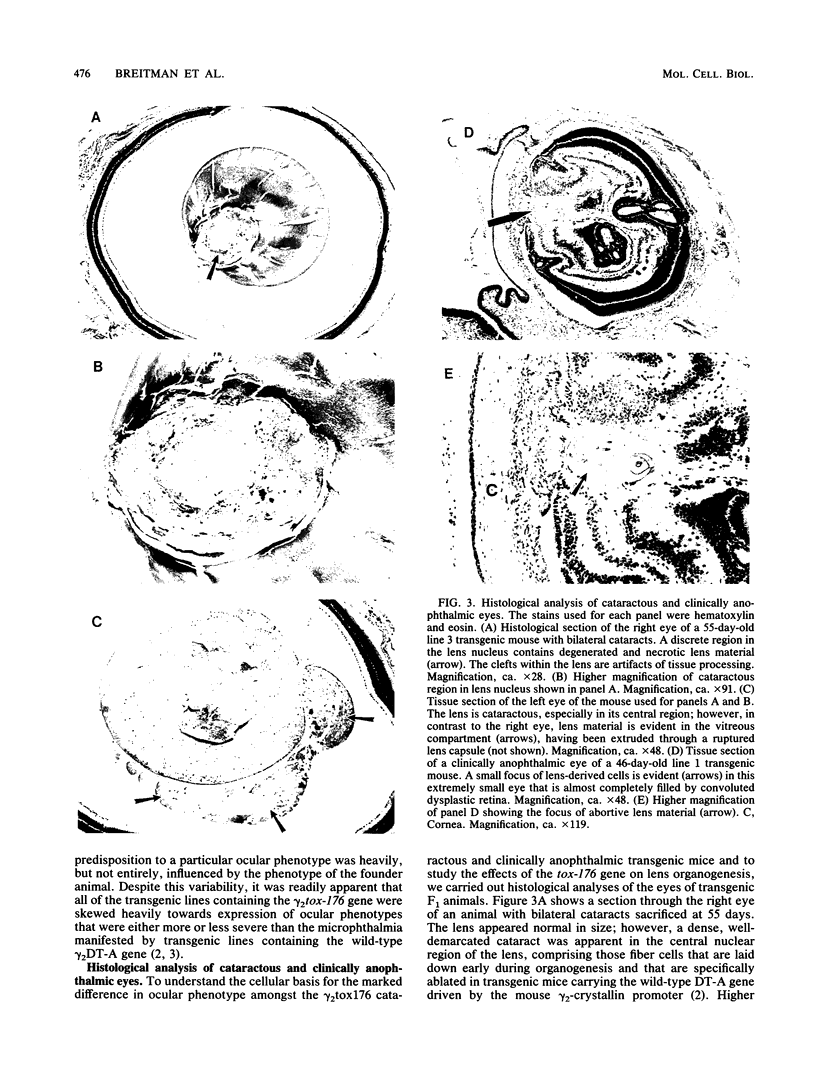
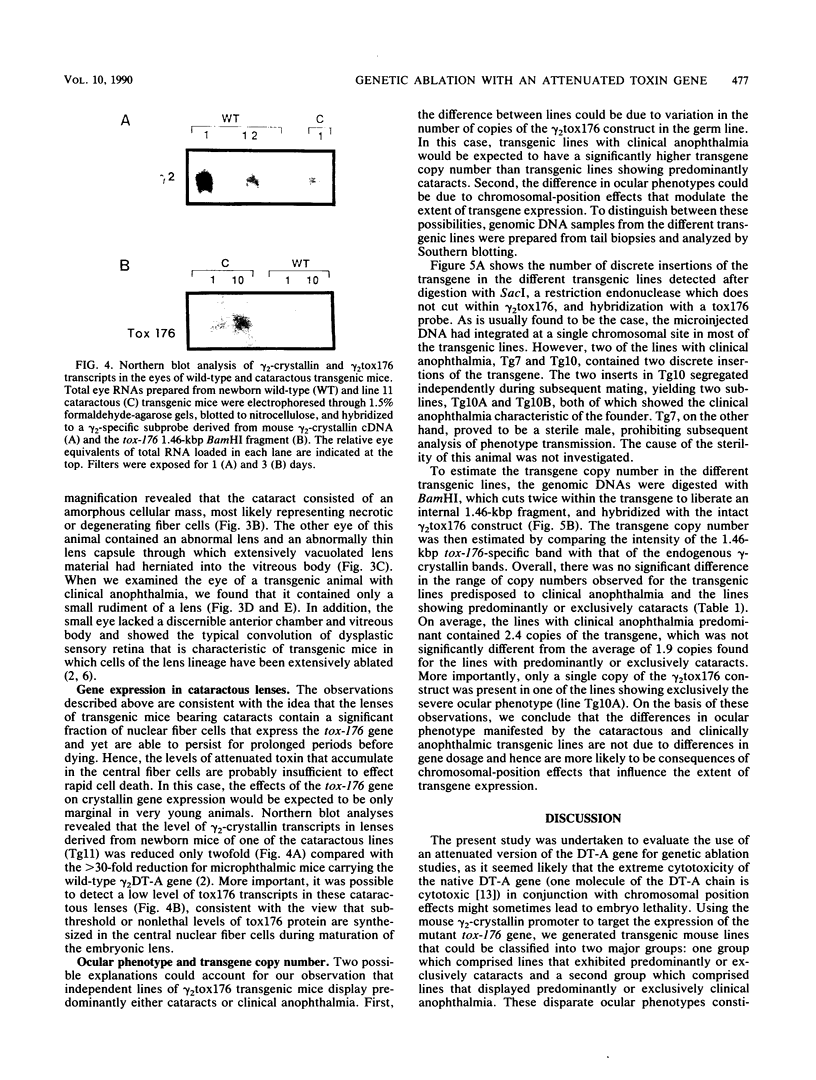
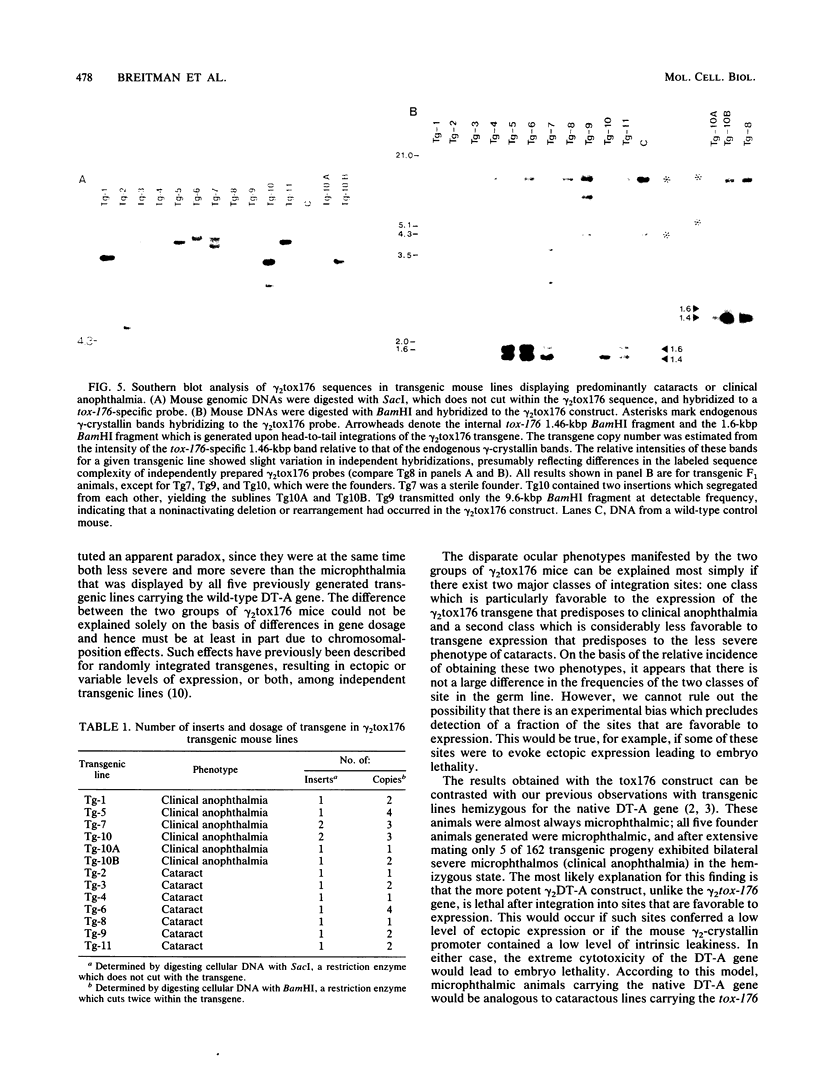
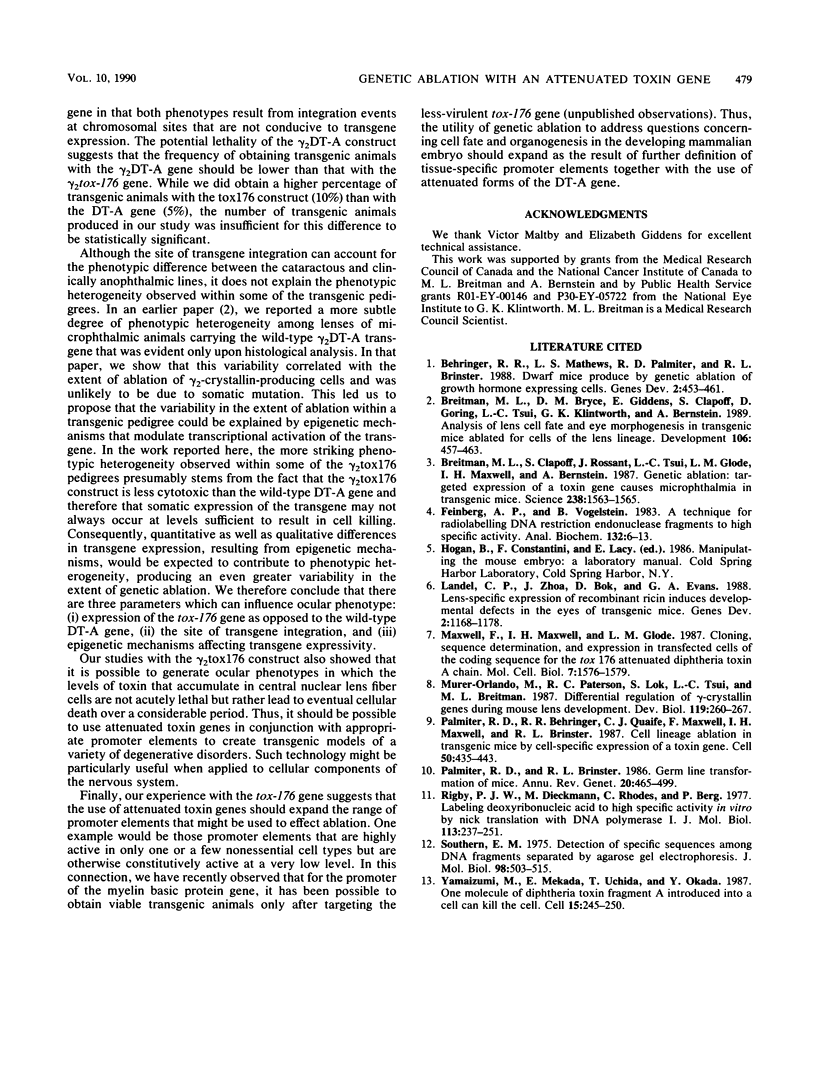
Images in this article
Selected References
These references are in PubMed. This may not be the complete list of references from this article.
- Behringer R. R., Mathews L. S., Palmiter R. D., Brinster R. L. Dwarf mice produced by genetic ablation of growth hormone-expressing cells. Genes Dev. 1988 Apr;2(4):453–461. doi: 10.1101/gad.2.4.453. [DOI] [PubMed] [Google Scholar]
- Breitman M. L., Bryce D. M., Giddens E., Clapoff S., Goring D., Tsui L. C., Klintworth G. K., Bernstein A. Analysis of lens cell fate and eye morphogenesis in transgenic mice ablated for cells of the lens lineage. Development. 1989 Jul;106(3):457–463. doi: 10.1242/dev.106.3.457. [DOI] [PubMed] [Google Scholar]
- Breitman M. L., Clapoff S., Rossant J., Tsui L. C., Glode L. M., Maxwell I. H., Bernstein A. Genetic ablation: targeted expression of a toxin gene causes microphthalmia in transgenic mice. Science. 1987 Dec 11;238(4833):1563–1565. doi: 10.1126/science.3685993. [DOI] [PubMed] [Google Scholar]
- Feinberg A. P., Vogelstein B. A technique for radiolabeling DNA restriction endonuclease fragments to high specific activity. Anal Biochem. 1983 Jul 1;132(1):6–13. doi: 10.1016/0003-2697(83)90418-9. [DOI] [PubMed] [Google Scholar]
- Landel C. P., Zhao J., Bok D., Evans G. A. Lens-specific expression of recombinant ricin induces developmental defects in the eyes of transgenic mice. Genes Dev. 1988 Sep;2(9):1168–1178. doi: 10.1101/gad.2.9.1168. [DOI] [PubMed] [Google Scholar]
- Maxwell F., Maxwell I. H., Glode L. M. Cloning, sequence determination, and expression in transfected cells of the coding sequence for the tox 176 attenuated diphtheria toxin A chain. Mol Cell Biol. 1987 Apr;7(4):1576–1579. doi: 10.1128/mcb.7.4.1576. [DOI] [PMC free article] [PubMed] [Google Scholar]
- Murer-Orlando M., Paterson R. C., Lok S., Tsui L. C., Breitman M. L. Differential regulation of gamma-crystallin genes during mouse lens development. Dev Biol. 1987 Jan;119(1):260–267. doi: 10.1016/0012-1606(87)90227-2. [DOI] [PubMed] [Google Scholar]
- Palmiter R. D., Behringer R. R., Quaife C. J., Maxwell F., Maxwell I. H., Brinster R. L. Cell lineage ablation in transgenic mice by cell-specific expression of a toxin gene. Cell. 1987 Jul 31;50(3):435–443. doi: 10.1016/0092-8674(87)90497-1. [DOI] [PubMed] [Google Scholar]
- Palmiter R. D., Brinster R. L. Germ-line transformation of mice. Annu Rev Genet. 1986;20:465–499. doi: 10.1146/annurev.ge.20.120186.002341. [DOI] [PMC free article] [PubMed] [Google Scholar]
- Rigby P. W., Dieckmann M., Rhodes C., Berg P. Labeling deoxyribonucleic acid to high specific activity in vitro by nick translation with DNA polymerase I. J Mol Biol. 1977 Jun 15;113(1):237–251. doi: 10.1016/0022-2836(77)90052-3. [DOI] [PubMed] [Google Scholar]
- Southern E. M. Detection of specific sequences among DNA fragments separated by gel electrophoresis. J Mol Biol. 1975 Nov 5;98(3):503–517. doi: 10.1016/s0022-2836(75)80083-0. [DOI] [PubMed] [Google Scholar]
- Yamaizumi M., Mekada E., Uchida T., Okada Y. One molecule of diphtheria toxin fragment A introduced into a cell can kill the cell. Cell. 1978 Sep;15(1):245–250. doi: 10.1016/0092-8674(78)90099-5. [DOI] [PubMed] [Google Scholar]






